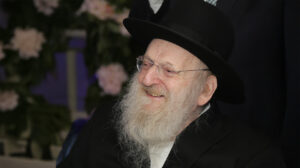Omaha’s Forgotten Sage


To many people, “Sage of Omaha” is the business world’s moniker for a plainspoken white-haired Midwesterner named Warren Buffet, who has parlayed brilliant market forecasting skills into a financial empire valued in the tens of billions of dollars. But it wasn’t even 70 years ago that a man who was a true sage in the age-old Jewish sense graced Nebraska’s largest city.
His name was Rav Zvi Hirsch Grodzinsky, and if a book were to be written called Great but Unknown Gedolim, his name would surely be toward the front of that volume. How else to describe someone whose name draws blank expressions from today’s average kollel yungerman, yet was considered the gadol hador by no less than Rav Yosef Eliyahu Henkin?
But, eventually, redemption comes. And so it has slowly begun to arrive for the rich Torah legacy, forgotten for nearly a century now, of Omaha’s venerable chief rabbi. Its redeemers make for an interesting duo in their own right. One, Rabbi Myron Wakschlag, is a native son of Omaha on a mission to spread the Torah of his hometown’s little-known gaon, while the other, Shalom Jacob, is a busy big-firm attorney whose true love is seforim and the people who write them.
Neither lives anywhere near the Cornhusker State, but to visit the Wakschlags in Silver Spring, Maryland and the Jacobs in Monsey, New York is to find Rav Grodzinsky very much alive. Mindful of Chazal’s dictum that the lips of a deceased talmid chacham continue to move as his teachings are repeated in this world, the two are working steadily to bring this towering Torah personality ever more to life with the publication of each additional piece of his written legacy.
Rav Zvi Hirsch was one of a number of litvish rabbanim who made their way from the Old Country — where Jewish life thrived but grinding poverty was the norm — to the shores of the USA, where the promise of a more comfortable material situation often came at a steep spiritual cost. Of this cadre, Rav Zvi Hirsch was surely among the most prominent of its members, in both his familial and personal standing.
Away from the Crowds
Born in the Lithuanian city of Novardok in 1857, he was a second cousin of Rav Chaim Ozer Grodzinsky, who was five years his junior. As a teenager, Zvi Hirsch came to Ivye, where Rav Chaim Ozer’s father, Rav Dovid Shlomo, served as rav. He lived in the Grodzinsky home and learned together with young Chaim Ozer, later moving on to learn in Vilna and Kovno and in the renowned Volozhin yeshivah as well.
In 1880, Rav Zvi Hirsch married Bayla, of the well-to-do Levitan family of Tavrig, and the family’s support enabled him to continue learning for ten years following his marriage. By 1891, the couple had been blessed with five children; another two would follow after their emigration to America. The 33-year-old Rav Zvi Hirsch had by then established himself as a talmid chacham of stature; indeed, the Brisker Rav is reported to have said that had Rav Zvi Hirsch remained in Europe, he would have grown to be greater in Torah than his younger cousin and erstwhile chavrusa.
But the New World beckoned. Only four years earlier, Rav Yaakov Yosef, the famed Maggid of Vilna and a leading disciple of Rav Yisrael Salanter, had accepted the invitation of a coalition of New York City shuls to become the chief rabbi of that metropolis. That experiment ended in failure just a few years later when Rav Yosef passed away, heartbroken over the implacable opposition and communal strife he faced from the moment he had arrived. But his presence in the United States paved the way for many young litvish rabbanim to venture overseas to the spiritually forbidding terrain of the treifene medinah. Between 1889 and 1892 alone, graduates of Lita’s leading yeshivos took positions as rabbanim in New York, St. Louis, Boston, Philadelphia, Rochester, and Des Moines.
And so, when a written invitation arrived for Rav Grodzinsky to serve as chief rabbi in Omaha, Nebraska, with the city’s two major shuls each contributing toward a monthly salary of $50, he accepted the offer. His wife and children remained behind in Tavrig, joining him in Omaha two years later, in 1893. Although many of the rabbinic émigrés to American shores took up residence in the heavily Jewish urban areas along the East Coast, Rav Zvi Hirsch appears to have preferred the relative solitude of the Midwestern plains, far from the contentiousness that prevailed in some of the larger kehillos.
Rav Grodzinsky was thankful for the opportunity the shteller in Omaha gave him to sit and learn undisturbed and produce his remarkably prodigious output of Torah writings. In his early years in America he took an active role in rabbinic circles, traveling often to the East Coast when the need arose, such as to participate in the founding meeting of the Agudas Harabonim and to deliver a eulogy at Rav Yaakov Yosef’s levayah. But he also spoke out strongly for the important role played by rabbis in the so-called American boondocks. Reacting to one particular edict that New York rabbanim had promulgated, he wrote in his sefer Mikraei Kodesh that “the rule is not as the rabbis of New York think, that the rest of the country of America is secondary to New York, for indeed it is the opposite.”
Oops! We could not locate your form.












